人教版新课标高一英语必修四Unit 4 Body Language 阅读课教学设计
- 格式:doc
- 大小:32.50 KB
- 文档页数:3


![新人教必修四 Unit 4 Body Language-Reading[课件]](https://uimg.taocdn.com/796df44826fff705cc170aed.webp)

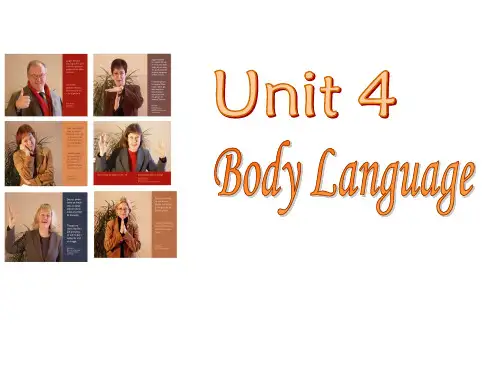
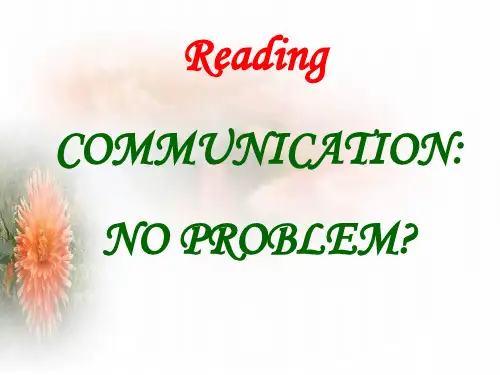
![人教新课标必修四 Unit 4 body language-Reading2[说课课件]](https://uimg.taocdn.com/02212a8c87c24028905fc35e.webp)
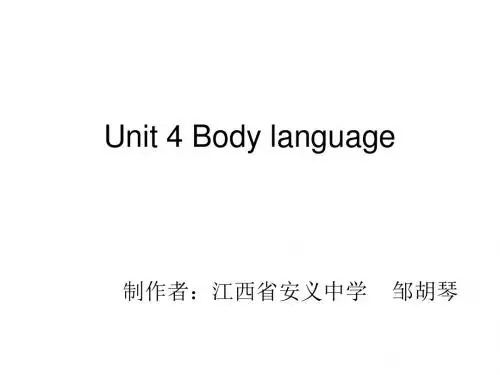
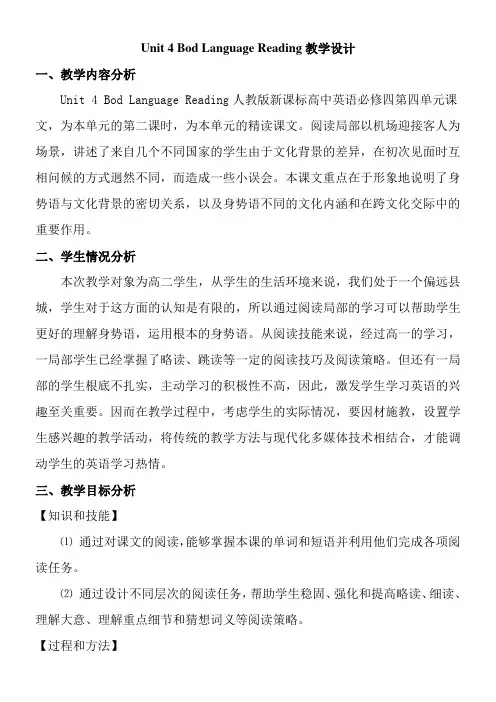
Unit 4 Bod Language Reading教学设计一、教学内容分析Unit 4 Bod Language Reading人教版新课标高中英语必修四第四单元课文,为本单元的第二课时,为本单元的精读课文。
阅读局部以机场迎接客人为场景,讲述了来自几个不同国家的学生由于文化背景的差异,在初次见面时互相问候的方式迥然不同,而造成一些小误会。
本课文重点在于形象地说明了身势语与文化背景的密切关系,以及身势语不同的文化内涵和在跨文化交际中的重要作用。
二、学生情况分析本次教学对象为高二学生,从学生的生活环境来说,我们处于一个偏远县城,学生对于这方面的认知是有限的,所以通过阅读局部的学习可以帮助学生更好的理解身势语,运用根本的身势语。
从阅读技能来说,经过高一的学习,一局部学生已经掌握了略读、跳读等一定的阅读技巧及阅读策略。
但还有一局部的学生根底不扎实,主动学习的积极性不高,因此,激发学生学习英语的兴趣至关重要。
因而在教学过程中,考虑学生的实际情况,要因材施教,设置学生感兴趣的教学活动,将传统的教学方法与现代化多媒体技术相结合,才能调动学生的英语学习热情。
三、教学目标分析【知识和技能】⑴通过对课文的阅读,能够掌握本课的单词和短语并利用他们完成各项阅读任务。
⑵通过设计不同层次的阅读任务,帮助学生稳固、强化和提高略读、细读、理解大意、理解重点细节和猜想词义等阅读策略。
【过程和方法】通过对文章的阅读,利用不同的阅读任务,帮助学生完成快速阅读、精读等练习来提高学生的阅读能力。
【情感态度价值观】通过对文章的理解及学生小组场景表演,让学生懂得交流与沟通不仅仅局限于语言,还可以借助肢体语言形象表达出自己的情感,不同的文化背景的人们对身势语有不同的理解。
四、教学重点难点分析【Ste eworour bet to rete the ore bod anguage from different countrie〔设计意图:作业1为学生创造了稳固课文、运用语言的时机,引导学生对已有的知识进行加工整合,有利于学生思维能力和语言表达能力的提高。
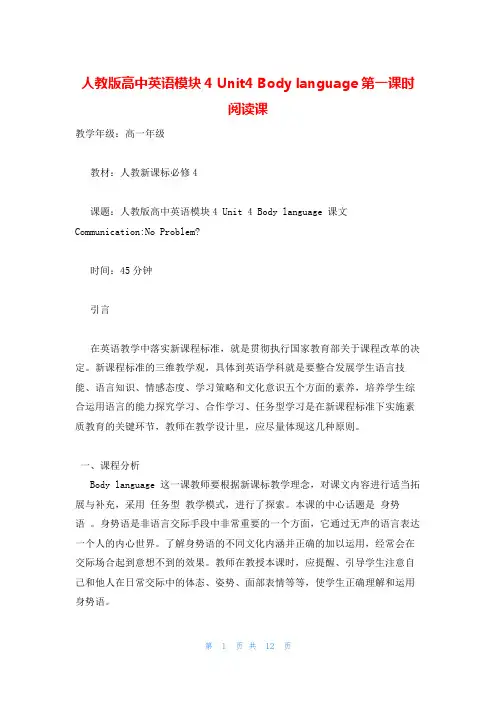
人教版高中英语模块4 Unit4 Body language第一课时阅读课教学年级:高一年级教材:人教新课标必修4课题:人教版高中英语模块4 Unit 4 Body language 课文Communication:No Problem?时间:45分钟引言在英语教学中落实新课程标准,就是贯彻执行国家教育部关于课程改革的决定。
新课程标准的三维教学观,具体到英语学科就是要整合发展学生语言技能、语言知识、情感态度、学习策略和文化意识五个方面的素养,培养学生综合运用语言的能力探究学习、合作学习、任务型学习是在新课程标准下实施素质教育的关键环节,教师在教学设计里,应尽量体现这几种原则。
一、课程分析Body language 这一课教师要根据新课标教学理念,对课文内容进行适当拓展与补充,采用任务型教学模式,进行了探索。
本课的中心话题是身势语。
身势语是非语言交际手段中非常重要的一个方面,它通过无声的语言表达一个人的内心世界。
了解身势语的不同文化内涵并正确的加以运用,经常会在交际场合起到意想不到的效果。
教师在教授本课时,应提醒、引导学生注意自己和他人在日常交际中的体态、姿势、面部表情等等,使学生正确理解和运用身势语。
二、学情分析海丰县仁荣高一(1)班学生们主要住在学校,学生基础属于面上中学比较好的一部分。
大部分学生的思维活动、学习热情、表现欲望和合作精神在平时的教学中表现很好。
他们虽然基本具备一定的电脑操作知识和网上搜索和查阅知识的能力,但现实生活中,我校(本地区)学生很难有条件在课前、课后利用网络资源或图书馆查找有关资料对教学内容进行了解,至于实现师生、生生资源共享也只是空话。
老师要自己想办法调动全班学生的积极性,在师生互动、生生互动中实现教学任务和目标。
学生对于外国文化了解并不多,但他们对本单元话题还是较感兴趣,通过教师适当指导,他们应可以对于本单元的文化知识有更进一步了解。
三、学习目标1、了解文化差异和身势语的变化;2、培养学生掌握一定的阅读技巧,学习使用有关预测、猜测的技巧;3、培养学生用英语表达身势语,达到用英语交流、培养实际运用英语能力的目的。
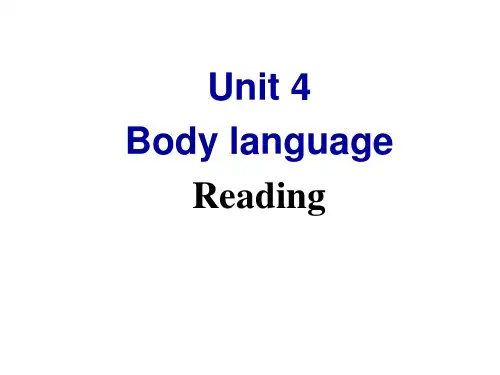
Unit 4 Body languageTeaching Plan for Reading and ComprehendingThe Analysis of Teaching ContentThe pre-reading part is made up of four questions, which lead students to think about the purpose of language,how many ways can be used to greet others by using body language and predicting the reading content.In the reading part,it tells us some misunderstanding caused by the students from different countries using different greeting ways when they meet for the first time in the airport. It shows the close relationship between body language and culuagtural background vividly, as well as the important role of body language in our daily life.The comprehending part is the consolidation of the whole passage. There are three exercises, which are in the form of chart, question and discussion.It is helpful for students to master the use of body language.Teaching goals:1. Enable the students to realize the importance of body language.2. Help the students learn how to explain the common idea--" different cultures, different body languages" with the target language in this unit.Teaching Important Points:1.Teach the students how to understand body language used in different countries or cultures as well as in different occasions.2. Enable students to use body language correctly in different situation.Teaching Difficult Points:Let the students know that there is both positive body language and negative body language.Teaching Methods:Skimming method, task-based method, role-play method.Teaching Aids:A recorder, a projector, a computer, and the blackboardTeaching Procedures:Step 1. Lead-in and RevisionT: Today, we will go on to learn Unit 4 Body language. And can you tell me what the purpose of language is?Ss: Communicating.T: Yes, communicating. And what about body language? Do you know what this gesture means?Ss: I love you.T: Great! The purpose of body language is also communicating.Just now, we got to know that we can use some gesture to express a certain meaning. Now, I have got another question for you. Does the same gesture always have the same meaning?Ss: No.T: Why? Can you give me some examples?Ss: …T: Now, let me see how much you know about it. Let’s fill in the chart together. Ss: …T: Good. Now, we know that not all the gestures always have the same meaning. While, in the other hand, does the same meaning always use the same gesture to express?Ss: No.T: Can you show me some examples? Here, let’s fill in the chart together. Ss: …T: Good. So far, we’ve learnt that not all the gestures always have the same meaning, and the same meaning doesn’t use the same gesture to express. Why?Ss: Because they are from different countries and different cultures.T: Great!Step 2. SkimmingT: Till now, we can make a conclusion: different culture, different body language. Now, just suppose. If a person can speak English very well, but doesn’t know much about body language, can he/she communicate with foreigners perfectly or very well?Ss: No.T: Right, just because of different culture, different body language, we should not only learn to speak English as well as we can, but also get hang of the body language. Now, do you want to know more about different culture, different body langrage?Ss: Yes.T: Well, let’s turn to page 26. Go through the text as fast as you can, then, finish the exercises on the screen:Ss:...Step 3. Scanning[First, get the students to read the text again, and then work together with their partners so as to grasp the general idea of the text.]T: What do you expect to know at the sight of the title " Communication: No Problem?" ? Now please skim the passage to get a general understanding of thewhole passage. While reading, please try to divide the whole passage into several parts and find out the main idea of each part (helping the students to fulfill the task if necessary).Part 1 (Para. l): I went to the airport to meet the international students. Part 2 (Paras.2-4 ) : People from different countries have different body language .Part 3 (para.5): Summary of body language.T: Now class, what does the text mainly tell us about?S1: It tells us the importance of " body language" .S2: It tells us the necessity of getting to know " body language" .S3: It tells us the differences of " body language" between different cultures. S4: It shows us some concrete cases in which " body language" is used.Step 4. Careful readingT: Very good. Now let's get down to the detailed parts of the text. Look at the following chart. Try to fill in the missing parts according to the text.Name Description Body language To whomTony Garcia man fromColombiaKiss on the cheek everyoneJulia Smith Woman fromBritainNo touching everyoneAkira Nagata Man from Japan bowing everyone George Cook Man from Canada Shaking hands everyongAhmed Aziz Man from Jordan Shaking handsNodding and notouching To men To womenDarlene Coulon Woman fromFrance Shake hands andkiss twice on eachcheekadultsT: According to your chart, how many different greeting ways are included? And what are they?S: There are four different greeting ways. They are:shaking hands; bow; kiss twice on the cheek;nodding.Step 5. ListeningT: Listen to the passage, and then decide the statements on the screen are true(T) or false(F).Ss:...Step 6. Role-playT: Body language, as a way of communicating, should be acted out. So it is important for students to practice. Students are divided into several groups to act the passage out: How do the foreign students meet for the first time. Are you clear?Ss: Yes.Step 7. SummaryT: What can we learn from this lesson?S1: When communicating with others, we can use not only spoken language, written language, but also body language, such as postures, facial expressions, gestures and so on.S2. Body language divides from culture to culture. Sometimes, the same gesture has different meanings, while sometimes, some different gestures have the same meaning. So we should always remember: different culture, different body language.T: Very good!Step 8. HomeworkPreview the language points in the text。
人教版新课标高中英语必修四Unit 4 Body Language 阅读课一、教材分析1.教学内容分析本节课是这个单元的第三课时,为精读课。
课文是以作者去机场迎接外国学生为场景,讲述了几个不同国家的学生由于文化背景的差异,初次见面时互相问候的方式迥然不同所导致的误会。
形象地表明了身势语与文化背景的密切关系,以及身势语不同的文化内涵和在跨文化交际中的重要作用。
2.学生情况分析经过高一一学年的英语学习,一部分学生已经掌握了略读、跳读等一定的阅读技巧及阅读策略。
但还有一部分的学生基础不扎实,主动学习的积极性不高,因此,激发学生学习英语的兴趣至关重要。
高中英语的教学重点是使学生掌握基础的语言知识和语言技能,因而在教学过程中,考虑学生的实际情况,要因材施教,设置学生感兴趣的教学活动,将传统的教学方法与现代化多媒体技术相结合,才能调动学生的英语学习热情。
二、教学目标分析1.知识与能力目标⑴通过对课文的阅读,能够掌握本课的单词和短语并利用他们完成各项阅读任务。
⑵通过设计不同层次的阅读任务,帮助学生巩固、强化和提高略读、细读、理解大意、理解重点细节和猜测词义等阅读策略。
2.情感态度目标通过对文章的理解及学生小组场景表演,让学生懂得交流与沟通不仅仅局限于语言,还可以借助肢体语言形象表达出自己的情感,不同的文化背景的人们对身势语有不同的理解。
3. 学习策略目标通过对文章的阅读,利用不同的阅读任务,帮助学生完成快速阅读、精读等练习来提高学生的阅读能力。
4. 教学方法及教学手段⑴采用任务型教学方法,启发式教学,激发学生学习积极性,完成教学任务。
⑵运用现代化多媒体进行教学,丰富课堂内容,调动学生课堂气氛。
三、教学重点、难点1.教学重点使学生了解不同的文化背景的人,他们的身势语是不同的,尤其是打招呼的方式。
另外,在阅读的基础上,重视学生阅读方法和阅读技巧的引导,完成阅读能力的培养。
2.教学难点⑴如何利用略读、细读等阅读技巧完成所给的阅读任务,通过这样的阅读手段形成阅读策略。
⑵课堂教学中,在提高学生阅读理解能力的基础上,全面训练学生的听、说、读、写能力。
四、教学过程Step I. Greetings.The teacher greets students as usual.Step II. Lead-in1.T: Do you know what the body language is?The body language is one form of communication without speaking, such as gestures, facial expressions and postures.(通过幻灯片展示的图片,形象生动地让学生了解什么是肢体语言,调动学生的学习热情,同时引出我们本节课的阅读主题。
)2.Revisive the words in the passage.通过复习课文的有关词汇,帮助学生在阅读过程中能准确理解整体课文。
Step III. While-reading1.Fast-reading: Listen to the recording, read and answer the following questions.①How many international students are there in the country?Six.②Who are they and where they come from?2.Scanning: Match the main idea for each part.Part 1 People from different countries have different body language.(Para1)Part 2 Summary of body language.(Para2-4)Part 3 I went to the Airport to meet the international students.(Para5)培养整体快速阅读能力,学会关注语篇的内容和结构,抓住文章的主体大意。
3.Careful-reading:1. Ask students to find out the two mistakes that the author noticed.The first cultural mistake:Tony Garcia: He approached Julia, touched ______________and _________her on the ________. Julia Smith: She ____________ appearing _________ and put up her hands as if _____________. The second cultural mistake:George Cook: He __________ his hand ________ to the Japanese.Akira Nagata: He __________ to George but his nose _________ George’s ___________ hand.2. Choose the best answer to each question.①The author in the passage is _____.A. a femaleB. a maleC. a representative of the Chinese governmentD. the boss of a big company.②Why are the international students visiting China?A. Because they like the friendly people and the delicious food of China.B. Because they have received invitations from the government.C. Because they are interested in developing business in China.D. Because China is becoming more and more powerful now.③What parts of the world are not represented by the visitors?A. Africa, Australia and Central America.B. Europe and Asia.C. The Middle Eastern, Africa and America.D. Only Australia.④Which of the following statements is NOT true ?A. Body language is important because it helps avoid misunderstanding.B. Some of the languages are good while others are bad and rude.C. A man from the Middle Eastern tends to greet men and women in different ways.D.French people will often kiss people they know on both cheeks.通过对文章的细读,培养学生用英语进行思维的良好习惯,也是加强学生在细节理解的基础上强化学生进行推理判断的能力培养。
Step IV. Post-reading1. Fill in the blanks with suitable words from the text.If you have a chance to observe several foreign visitors from different countries getting together, you’ll surely experience some _______________ that will happen among them in body language due to the difference of their ________. For example, when at the first meeting, Colombians like to __________ others,__________ their shoulders and kiss them on the cheek, while the British will keep a certain distance from others; Canadians will _______ hands, while Japanese will _______.From the above examples, we know that all cultures don’t _________ each other the same way.In short, as well as ________ language, our body language can also express our __________ through physical distance, actions or posture. But remember that _______ of the actions or posture is good or bad, and they are just the ways of communicating with people. Different cultures result in different body language.2. Role play.Ask some students work in groups and try to act out the story in the text. Different students represent different parts of the world, and use body language to greet each other.通过对前面几个环节的环环相扣,这部分可以使学生在文章的理解之后的语言综合运用能力得到锻炼。